
Australian construction company trials Cloud and enterprise wireless solution.
Australian-based Taylor Construction demonstrates firsthand that 5G has arrived, setting a new standard for 5G-enabled high-tech applications for the enterprise.
Cradlepoint, the global leader in cloud-delivered LTE and 5G wireless edge solutions, today announced that Taylor Construction has completed its 5G trial and is successfully using a 5G for business solution. This is the first documented 5G enterprise use case with an enterprise-grade 5G edge networking solution by Cradlepoint.
Taylor Construction is already experiencing the wide area network (WAN) speeds and coverage it needs — including 20 times the performance of its 4G connection — to support a range of bandwidth and latency sensitive connected devices and applications on its construction sites.
Following the February 2020 release of Cradlepoint’s comprehensive portfolio of 5G wireless edge solutions for business in Australia, and its coinciding rollout with Telstra’s high-performance 5G network, Taylor Construction took action. The company identified a construction site where it could trial Telstra’s Enterprise Wireless solution and Cradlepoint’s NetCloud Service for Branch, delivered through a Cradlepoint E3000 5G-optimised router with a ruggedised W2005 5G Wideband Adapter built for outdoor placement.
“The Cradlepoint 5G solution, enabled by the Telstra 5G network, has transformed our ability to employ high-performing enterprise-grade applications, top to bottom,” said Christian Neyle, IT manager for Taylor Construction. The performance the company is now getting with 5G will enable it to deploy its current 5G-ready high-tech applications, made possible by the Wireless WAN. Taylor is experimenting with the following applications:
- Holographic Building Visualisation — Microsoft HoloLens is a type of mixed-reality smart glasses that Taylor employees and customers can wear on-site to render a virtual model of the building or elements of the construction process such as holographic structural steel, framing, or electrical schematics.
- Wide-Area Safety Scanning — 360-degree 8K streaming and QR code scanning from wireless video cameras enables digital induction tracking, which improves risk management by automating the process of ensuring every person on site has completed safety training.
- IoT Structural Sensing — Smart sensors affixed to rebar and embedded in concrete aggregate and send data to the Cradlepoint router, then onto the cloud. This can help Taylor determine if concrete is poured correctly and track any shifting of the concrete for years to come.
- Real-Time Design Display — The Taylor team needs to be able to make changes to digital blueprints in real time and display on tablets and large monitors in the trailer.
- Large-Site Failover — The IT team also would like to investigate replacing their expensive back-up fibre line with 5G, gaining fiber-like speeds with the diversity of a wireless connection.
“To some people, this is science fiction; to me, this is the next generation of business,” said Neyle. “We could have used fibre, but mobility was also important, which is why 5G is the only solution that works.” All of these aforementioned devices and applications require real-time data, which is only possible with immense bandwidth, low latency, and constant uptime at the edge of the network. Thus, it’s only possible with 5G.
Businesses are serious about utilising 5G solutions to boost operations and outcomes—Taylor Construction is a prime example of this. And according to the Cradlepoint Wireless Networks Study Australia 2020 by Telsyte report, 67 percent of IT decision-makers are either confident or very confident that 5G will deliver business benefits within the next year.
Telstra’s Enterprise Wireless solution, which provides the 5G service for Taylor Construction, exemplifies the significant opportunity for mobile network operators as businesses of all size and across industries embrace 4G and 5G technologies, and make the shift to Wireless WAN.




